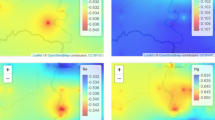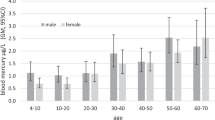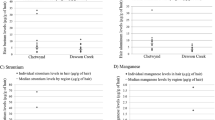Abstract
Blood lead concentrations are higher in young children than in other age groups, whereas little is known regarding concentrations of other metals in young children. We measured the concentrations of a suite of metals in the blood of children 1–6 years of age, and assessed potential differences by age, season, or region of Maine. We used blood submitted to the Maine State Health and Environmental Testing Laboratory for blood lead analysis to determine the concentrations of arsenic (As), antimony (Sb), cadmium (Cd), manganese (Mn), mercury (Hg), selenium (Se), tin (Sn), and uranium (U) in 1350 children 1–6 years of age. The essential metals Mn and Se were detected in all samples, and As and Sb were detected in >90% of samples. Hg was detected in approximately 60% of samples. U and Cd were less often detected in blood samples, at approximately 30% and 10% of samples, respectively. Sn was not detected in any sample. Concentrations of As, Hg, and Se increased with age, whereas Sb decreased with age. Concentrations also varied by season and region for some though not all metals. Significant pairwise correlations were observed for a number of metals. Blood is a reasonable compartment for measurement of most of these metals in young children. The use of convenience samples provided a cost-effective mechanism for assessing exposure of young children in Maine.
This is a preview of subscription content, access via your institution
Access options
Subscribe to this journal
Receive 6 print issues and online access
$259.00 per year
only $43.17 per issue
Buy this article
- Purchase on Springer Link
- Instant access to full article PDF
Prices may be subject to local taxes which are calculated during checkout


Similar content being viewed by others
References
Aschner J.L., and Aschner M. Nutritional aspects of manganese homeostasis. Mol Aspects Med 2005: 26: 353–362.
Borak J., and Hosgood H.D. Seafood arsenic: implications for human risk assessment. Regulatory Toxicol Pharmacol 2007: 47: 204–212.
Burk R.F., and Levander O.A. Selenium. In: Shils M., Olson J., Shike M., and Ross A.C. (Eds.). Modern Nutrition in Health and Disease, 9th edn. Williams & Wilkins, Baltimore, 1999, pp. 265–276.
Cao Y., Chen A., Radcliffe J., Dietrich K.N., Jones R.L., Caldwell K., and Rogan W.J. Postnatal cadmium exposure, neurodevelopment, and blood pressure in children at 2, 5, and 7 years of age. Environ Health Perspect 2009: 117: 1580–1586.
CDC (Centers for Disease Control and Prevention). Fourth National Report on Human Exposure to Environmental Chemicals. http://www.cdc.gov/exposurereport/, 2009.
Chaudhuri S.N., Butala S.J.M., Ball W., Braniff C.T., and Rocky Mountain Biomonitoring Consortium Pilot study for utilization of dried blood spots for screening of lead, mercury and cadmium in newborns. J Exposure Sci Env Monitoring 2009: 19: 298–316.
Choi A.L., Budtz-Jørgensen E., Jørgensen P.J., Steuerwald U., Debes F., Weihe P., and Grandjean P. Selenium as a potential protective factor against mercury developmental neurotoxicity. Environ Res 2008: 107: 45–52.
De Boeck M., Kirsch-Volders M., and Lison D. Cobalt and antimony: genotoxocity and carcinogenicity. Mutat Res 2004: 533: 135–152.
EPA IRIS (Environmental Protection Agency Integrated Risk Information System). Reference dose, Reference Concentration, or Cancer Slope Factor for Cadmium and Antimony. http://www.epa.gov/iris/.
Florescu A., Ferrence R., Einarson T.R., Selby P., Kramer M., Woodruff S., Grossman L., Rankin A., Jacqz-Aigrain E., and Koren G. Reference values for hair cotinine as a biomarker of active and passive smoking in women of reproductive age, pregnant women, children, and neonates: systematic review and meta-analysis. Ther Drug Monit 2007: 29: 437–446.
Fowler B.A. Mechanisms of kidney cell injury from metals. Environm Health Perspect 1993: 100: 57–63.
Gebel T., Clausen K., and Dunkelberg H. Human biomonitoring of antimony. Int Arch Occup Environ Health 1998: 71: 221–224.
Glattre E., Mravcova A., Lener J., Vobecky M., Egertova E., and Mysliveckova M. Study of distribution and interaction of arsenic and selenium in rat thyroid. Biol Trace Elem Res 1995: 49: 177–186.
Hornung R.W. Health effects in underground uranium miners. Occup Med 2001: 16: 331–344.
Houpert P., Lestaevel P., Bussy C., Paquet F., and Gourmelon P. Enriched but not depleted uranium affects central nervous system in long-term exposed rat. Neurotoxicol 2005: 26: 1015–1020.
Kim R., Aro A., Rotnitzky A., Amarasiriwardena C., and Hu H. K x-ray fluorescence measurements of bone lead concentration: the analysis of low-level data. Phys Med Biol 1995: 40: 1475–1485.
Kim Y., Kim B-N., Hong Y-C., Shin M-S., Yoo H-J., Kim J-W., Bhang S-Y., and Cho S-C. Co-exposure to environmental lead and manganese affects the intelligence of school-aged children. Neurotoxicol 2009: 30: 564–571.
Kumar R., Rampal S., and Jindal R. Effect of experimentally induced subchronic selenosis on thyroid hormones and biochemical indices in calves. Iranian J Vet Res 2008: 9: 127–131.
Laclaustra M., Navas-Acien A., Stranges S., Ordovas J.M., and Guallar E. Serum selenium concentrations and diabetes in U.S. adults: National Health and Nutrition Examination Survey (NHANES) 2003–2004. Environ Health Perspect 2009: 117: 1409–1413.
Leblanc J-C., Guerin T., Noel L., Calamassi-Tran G., Volatier J-L., and Verger P. Dietary exposure estimates of 18 elements for the 1st French Total Diet Study. Food Additives Contam 2005: 22: 624–641.
Lestaevel P., Bussy C., Paquet F., Dhieux B., Clarençon D., Houpert P., and Gourmelon P. Changes in sleep-wake cycle after chronic exposure to uranium in rats. Neurotoxicol Teratol 2005: 27: 835–840.
Link B., Gabrio T., Piechtowski I., Zollner I., and Schwenk M. Baden-Wuerttemberg Environmental Health Survey (BW-EHS) from 1996 to 2003: toxic metals in blood and urine of children. Int J Hyg Environ-Health 2007: 210: 357–371.
Loiselle C., Marvinney R., and Smith E. Spatial distribution of arsenic in groundwater in Maine;Geological Society of America, 2001 annual meeting. Abstracts with Programs 2001: 33 (6): 54.
Madden E.F., and Fowler B.A. Mechanisms of nephrotoxicity from metal combinations: a review. Drug Chem Toxicol 2000: 23: 1–12.
Mahaffey K.R., Clickner R.P., and Jeffries R.A. Adult women's blood mercury concentrations vary regionally in the United States: association with patterns of fish consumption (NHANES 1999–2004). Environ Health Perspect 2009: 117: 47–53.
Maine SDWIS. Maine Safe Drinking Water Information System, Drinking Water Program, Maine Center for Disease Control and Prevention, Augusta, Maine, 2010.
McShane W.J., Pappas R.S., Wilson-McElprang V., and Paschal D. A rugged and transferable method for determining blood cadmium, mercury, and lead with inductively coupled plasma-mass spectrometry. Spectrochimica Acta Part B: Atomic Spectroscopy 2008: 63: 638–644.
Nordberg G.F., Jin T., Hong F., Zhang A., Buchet J.P., and Bernard A. Biomarkers of cadmium and arsenic interactions. Toxicol Appl Pharmacol 2005: 206: 191–197.
NRC (National Research Council). Toxicological Effects of Methylmercury. Committee on the Toxicological Effects of Methylmercury, Board on Environmental Studies and Toxicology, Commission on Life Sciences, National Research Council. National Academy Press, Washington, DC, 2000.
Olson O.E. Selenium toxicity in animals with emphasis on man. J Amer College Toxicol 1986: 5: 45–70.
Puig C., Garcia-Algar O., Monleon T., Pacifici R., Zuccaro P., Sunyer J., Figueroa C., Pichini S., and Vall O. A longitudinal study of environmental tobacco smoke exposure in children: parental self reports versus age dependent biomarkers. BMC Public Health 2008: 8: 47.
Richter P.A., Bishop E.E., Wang J., and Swahn M.H. Tobacco smoke exposure and levels of urinary metals in the U.S. youth and adult population: The National Health and Nutrition Examination Survey (NHANES) 1999–2004. Int J Environ Res Pub Health 2009: 6: 1930–1946.
Roth J.A. Homeostatic and toxic mechanisms regulating manganese uptake, retention, and elimination. Biol Res 2006: 39: 45–57.
Rükgauer M., Klein J., and Kruse-Jarres J.D. Reference values for the trace elements copper, manganese, selenium, and zinc in the serum/plasma of children, adolescents, and adults. J Trace Elements Med Biol 1997: 11: 92–98.
Sakurai T., Kojima C., Ochiai M., Ohta T., and Fujiwara K. Evaluation of in vivo acute immunotoxicity of a major organic arsenic compound arsenobetaine in seafood. Int Immunopharmacol 2004: 4: 179–184.
Sanchez D.J., Belles M., Albina M.L., Sirvent J.J., and Domingo J.L. Nephrotoxicity of simultaneous exposure to mercury and uranium in comparison to individual effects of these metals in rats. Biol Trace Elem Res 2001: 84: 139–154.
Schantz S.L., and Widholm J.J. Cognitive effects of endocrine-disrupting chemicals in animals. Environ Health Perspect 2001: 109: 1197–1206.
Smith A.H., Marshall G., Yuan Y., Ferreccio C., Liaw J., von Ehrenstein O., Steinmaus C., Bates M.N., and Selvin S. Increased mortality from lung cancer and bronchiectasis in young adults following exposure to arsenic in utero and early childhood. Environ Health Perspect 2006: 114: 1293–1296.
Taulan M., Paque F., Maubert C., Delissen O., Demaille J., and Romey M-C. Renal toxicogenomic response to chronic uranyl nitrate insult in mice. Environ Health Perspect 2004: 112: 1628–1635.
Thaqi A., Franke K., Merkel G., Wichmann H-E., and Heinrich J. Biomarkers of exposure to passive smoking of school children: frequency and determinants. Indoor Air 2005: 15: 302–310.
Thomas P., Irvine J., Lyster J., and Beauliea R. Radionuclides and trace metals inCanadian moose near Uranium mines: comparaison of radiation doses and food chain transfer with cattle and caribou. Health Physics 2005: 88: 423–438.
van Velzen D., and Herb G. Antimony, its sources, applications, and flow paths into urban and industrial waste: a review. Waste Manage Res 1998: 1: 320–340.
US Census. http://quickfacts.census.gov/qfd/states/23000.html, 2008.
Wasserman G.A., Liu X., Parvez F., Ahsan H., Factor-Litvak P., van Geen A., Slavkovich V., Lolacono N.J., Cheng Z., Hussain I., Momotaj H., and Graziano J.H. Water arsenic exposure and children's intellectual function in Araihazar, Bangladesh. Environ Health Perspect 2004: 112: 1329–1333.
Wasserman G.A., Liu X., Parvez F., Ahsan H., Levy D., Factor-Litvak P., Kline J., van Geen A., Slavkovich V., Lolacono N.J., Cheng Z., Zheng Y., and Graziano J.H. Water manganese exposure and children's intellectual function in Araihazar, Bangladesh. Environ Health Perspect 2006: 114: 124–129.
Wilhelm M., Ewers U., and Schulz C. Revised and new reference values for some trace elements in blood and urine for human biomonitoring in environmental medicine. Int J Hyg Environ Health 2004: 207: 69–73.
Wilhelm M., Schulz C., and Schwenk M. Revised and new reference values for arsenic, cadmium, lead, and mercury in blood or urine of children: basis for validation of human biomonitoring data in environmental medicine. Int J Hyg Environ Health 2006: 209: 301–305.
Wright R.O., Amarasiriwardena C., Woolf A.D., Jim R., and Bellinger D.C. Neuropsychological correlates of hair arsenic, manganese, and cadmium levels in school-age children residing near a hazardous waste site. Neurotoxicol 2006: 27: 210–216.
Ysart G., Miller P., Crews H., Robb P., Baxter M., De L’argy C., Lofthouse S., Sargent C., and Harrison N. Dietary exposure estimates of 30 elements from the UK Total Diet Study. Food Additives Contam 1999: 9: 391–403.
Zhang G., Liu D., and He P. Effects of manganese on learning abilities in school children. Zhonghua Yu Fang Yi Xue Za Zhi 1995: 29: 156–158.
Acknowledgements
This work was supported by a cooperative agreement (5U38EH000185) from the US Centers for Disease Control and Prevention, Environmental Public Health Tracking Branch. We thank the laboratory staff involved with the preparation of blood specimens for analysis and de-identification of samples (Frank Ricker, James Curlett).
Author information
Authors and Affiliations
Corresponding author
Ethics declarations
Competing interests
The authors declare no conflict of interest.
Rights and permissions
About this article
Cite this article
Rice, D., Lincoln, R., Martha, J. et al. Concentration of metals in blood of Maine children 1–6 years old. J Expo Sci Environ Epidemiol 20, 634–643 (2010). https://doi.org/10.1038/jes.2010.42
Received:
Accepted:
Published:
Issue Date:
DOI: https://doi.org/10.1038/jes.2010.42
Keywords
This article is cited by
-
Association of drinking-water source and use characteristics with urinary antimony concentrations
Journal of Exposure Science & Environmental Epidemiology (2013)
-
Blood Manganese Concentration is Elevated in Infants with Iron Deficiency
Biological Trace Element Research (2013)



